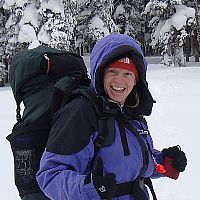Neal et al., 2010
Environmental Controls on Soil Respiration in Semiarid Ecosystems: The Role of the Vertical Distribution of Soil Moisture.
Neal, A.L., Kurc, S., Brooks, P.D. (2010)
AGU Fall Meeting (Poster) Abstract B31B-0290.
-
Shale Hills, STAFF
-
Catalina-Jemez, INVESTIGATOR
-
Catalina-Jemez, INVESTIGATOR
Abstract
Total ecosystem respiration incorporates both the autotrophic and heterotrophic components of respiration, which may respond differently to various environmental controls. Typically, soil temperature is considered the dominant control on soil respiration. However, in semiarid ecosystems, where soil temperatures are rarely low enough to inhibit respiration, soil moisture is a key driver. Many recent studies have investigated this soil moisture control on respiration in semiarid ecosystems, yet none have considered how the temporal and spatial variability in the vertical distribution of that soil moisture influences soil respiration. In pulse-driven semiarid ecosystems, consideration of the vertical distribution of soil moisture is critical because frequent small pulses of precipitation wet only the surface layer, while only infrequent and largely unpredictable large pulses of precipitation wet the deeper soil layers. We expect this variability in the vertical distribution of soil moisture to influence the water limitation on soil respiration in these semiarid ecosystems. Further, we expect that this link will be especially important in understanding the timing of autotrophic and heterotrophic contributions to total ecosystem respiration. In this study, we investigated the importance of multiple environmental controls (i.e. soil temperature, season, vegetation type, and soil moisture) on semiarid soil respiration using data from five Ameriflux sites located in the southwestern US (two grasslands, two shrublands and one savannah). We first examined a standard Q10 relationship between soil temperature and soil respiration; as expected, the relationship was not strong. Therefore, we categorized the temperature-respiration relationship by season, vegetation type, and soil moisture thresholds. We found that categorizing by season did not improve the ability to predict respiration, but ecosystem type (grass, shrub or savannah) categories did improve respiration predictions, though slightly. Using soil moisture categories had mixed results. While categories of root zone soil moisture did not improve predictions, when soil moisture thresholds were created based on shallow and deep zones and organized into wet and dry cases, we saw significant improvement in temperature-respiration relationships. We believe that our wet/dry vertical soil moisture framework is an important step in understanding carbon dynamics because it can define strong relationships between temperature and respiration irrespective of different site characteristics. Further, the framework can identify the components of ecosystem respiration. Respiration that occurs when the entire soil column is relatively dry is likely dominated by plant maintenance. Under wet conditions, respiration is largely due to microbial activity when only the surface is wet, while respiration that occurs when only the deep soil is wet can be linked to growth respiration following photosynthesis
Citation
Neal, A.L., Kurc, S., Brooks, P.D. (2010): Environmental Controls on Soil Respiration in Semiarid Ecosystems: The Role of the Vertical Distribution of Soil Moisture. AGU Fall Meeting (Poster) Abstract B31B-0290..
Explore Further



